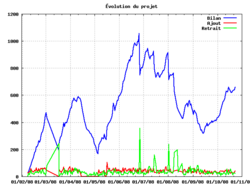User:DegapudiSudhipti/sandbox
This article includes a list of references, related reading, or external links, but its sources remain unclear because it lacks inline citations. (November 2007) |

Mobile social networking is social networking where individuals with similar interests converse and connect with one another through their mobile phone and/or tablet. Much like web-based social networking, mobile social networking occurs in virtual communities. A current trend for social networking websites, such as Facebook[1] , is to create mobile apps to give their users instant and real-time access from their device. In turn, native mobile social networks have been created like Foursquare and Gowalla, communities which are built around mobile functionality. More and more, the line between mobile and web is being blurred as mobile apps use existing social networks to create native communities and promote discovery, and web-based social networks take advantage of mobile features and accessibility. As mobile web evolved from proprietary mobile technologies and networks, to full mobile access to the Internet, the distinction changed to the following types: 1) Web based social networks being extended for mobile access through mobile browsers and smartphone apps, and 2) Native mobile social networks with dedicated focus on mobile use like mobile communication, location-based services, and augmented reality, requiring mobile devices and technology. However, mobile and web-based social networking systems often work symbiotically to spread content, increase accessibility and connect users from wherever they are.
History
[edit]The evolution of social networking on mobile networks started in 1999 with basic chatting and texting services. With the introduction of various technologies in mobile networks, social networking has reached to an advance level over four generations.[2]
First Generation
[edit]First generation began in 1900 or early 2000.Technologies used in this generation are application based, pre-installed on mobile handsets. Features such as text only chat via chat rooms. People involved who used these services are anonymous. . The services of this generation mobile social networks can be used by pay as you go or subscription to service.
Second Generation
[edit]Second generation began in 2004 through 2006. Introduction of 3G and camera phones added many features such as uploading photos, mobile search for person based on profile, contact / flirt with person anonymously etc. Regional distributions of these features include Japan, Korea, Australia, Western Europe and US. The applications are mostly useful for dating purpose. The services of this generation mobile social networks can be used by pay as you go or subscription to service.
Third Generation
[edit]The experiments for this generation mobile social networks started in 2006. It was adopted widely in 2008/2009. This generation brought tremendous changes and made mobile social networks as a part of daily life. The features include richer user experience, automatic publishing to web profile and status updates, some web 2.0 features, search by group / join by interests, alerts, location based services content sharing especially music etc.. Technologies for WAP 2.0, Java on the server, MMS, voice capture etc. Applications introduced were customized with general interests such as music, mobile specific content distribution. Regional distributions of this generation of mobile social networks include Japan, Korea, Western Europe, and North America. Advertising and ad supported content become increasingly important. The services in this generation can be used by plans such as pay as you go; subscription based still popular networks gain scale to become content distribution platform.
Fourth Generation
[edit]Fourth generation began in 2008 and reached in 2010.All the features in third generation are advanced in this generation of social mobile networks. The features of this generation include the features of third generation, ability to hide/ mask presence, asynchronous video conversation, multi point audio chat conversation with one button, multiplayer mobile gaming etc. Technologies which made these features possible are web 2.0 widgets, Flash lite, open social, open handset alliance. The business model of previous generation continued along with virtual currency –purchase and trade of virtual goods.
Types of Mobile Social Networks
[edit]Initially, there were two basic types of mobile social networks. The first is companies that partner with wireless phone carriers to distribute their communities via the default start pages on mobile phone browsers. An example of this is JuiceCaster. The second type is companies that do not have such carrier relationships (also known as "off deck") and rely on other methods to attract users.[3]
Models
[edit]Mobile social networking sites allow users to create a profile, send and receive messages via phone or computer and visit an on-line version of mobile site. There are different models which were adapted by different networking sites. Most of these sites have many features in unique feature or special function that other sites don’t share, but the main function of the site is the exact same as other services. All these sites are categorized according to the following business models.[4]
Group Texter
[edit]This model focuses on ability to send short, text based messages to a large group of people simultaneously. It can be by SMS or micro-blog. This category enables messages reach right people as quickly as possible.
Radar
[edit]Radar takes advantage of growing interest in location-based services by keeping track of all the contacts. This allows knowing people who are nearest to the user. A lot of these sites also allow you to check if there’s anyone near a particular venue or location, and some of them will actively alert you if any of your contacts comes within a certain distance.
Geo Tagger
[edit]This model is heavily location based. This allows users to tag particular locations with images and other information. These tags can be accessible by the users which are mapped on world map. Some of the sites in this category enable to receive alerts when the user passes by the location in which somebody was tagged in.
Dating Service
[edit]The sites using this model are almost identical versions of their online counter parts. Users create a profile and are matched with other profiles on-line. Some of these sites use radar so that they ping you if there is a matching single profile within a certain distance. These sites are marked with serious security measures, so that no personal details are released without user’s consent.
Social Networker
[edit]The sites using this try to use on-line social networking sites as closely as possible. Many of these sites use mobile portals of already existing and successful sites such as Facebook.They offer vast number of functions including multimedia posts, photo sharing instant messaging etc. Most of these sites offer inexpensive international calling and texting facilities.
Media Share
[edit]The sites using this model are almost the advanced version of the sites of Group Texter category. Instead of text messages, audio and video files are transmitted among the group. These sites are only concerned with sharing files as quickly and efficiently as possible with your friends and groups. Most of them store your phone content on-line so that your mobile doesn’t get clogged with large video files. These sites are dangerous when compared to other categories of sites.
Mobile Social Networking in United States
[edit]
[5] While Japan, Korea, China have a higher usage rate of mobile social networks compared to other western countries, the United States is a prevalent user of mobile social networks. The US has a population of 303.82 million people and a mobile penetration of 72% with 219.73 million mobile subscribers in 2008. Informa forecasts the number of mobile subscribers to rise to 243.27 million by 2013.
The mobile data market in the US is at a developed stage of growth where non-messaging data revenues account for 20% of US operators' overall data revenues. In September of 2012, the CTIA (Cellular Telephone Industries Association) announced that data service revenues rose 40% to US $14.8 billion. The CTIA announced that SMS usage had maintained its strong growth.
Social networking once began in the online space but it has rapidly spread to mobile platforms. Currently, consumption of mobile internet usage is being driven by mobile social networking. Data shows that the US has 220.14 million online Internet users which is 72.5% of the population. Flat-rate data plans have been prevalent in the US for a number of years but the customer adoption of mobile internet was slow until 2008.However, the introduction of the iPhone has definitely increased the market for mobile internet. iPhones have transformed the mobile social network market and today there is numerous mobile development for social network apps.
The US mobile social networking market experienced steady growth in 2008 with 6.4 million mobile social network users. Since then the number of mobile users have continued to grow and below is graph forecasting the growth until 2013.
See also
[edit]References
[edit]Further reading
[edit]- Lai, C.H. (2007) Understanding the design of mobile social networking. M/C Journal, Vol.10, N.1 (March 2007)
- Lugano, G. (2008) Mobile social networking in theory and practice. FirstMonday, Vol.13, N.11 (November 2008)
- Powers, William, Hamlet’s Blackberry : a practical philosophy for building a good life in the digital age, 1st ed., New York : Harper, 2010. ISBN 978-0-06-168716-7
- Raento, Mika (2008). "Designing for privacy and self-presentation in social awareness". Personal Ubiquitous Comput. 12 (7): 527–542. doi:10.1007/s00779-008-0200-9. Retrieved 2011-06-08.
{{cite journal}}: Unknown parameter|coauthors=ignored (|author=suggested) (help)
External links
[edit]- Business Week Online
- NY Times: "Social Networking Moves to the Cellphone" (itsmy.com, GyPSii, Facebook etc.)
- Land Surveyors United Support Network Mobile Global social support network featuring surveyor forums, instructional videos, industry news and support groups based on geolocation.
